Social media is a powerful tool to help you expand your reach and grow your business. But the tactic of "if you build it, they will come" no longer applies.
These platforms are more crowded than ever, and every brand is after the same goal: capturing the attention of their target audience to build brand awareness and increase revenue.
So what's the recipe for success on social media? It's all about posting the right content to ignite a spark within your followers to interact with your brand. After all, what's the point of having 1 million followers if they never engage with you?
When your followers are disengaged, they scroll right past your content, almost as if it doesn't exist. And all of your hard work goes right out the window. That's why it's crucial to focus on posting content that encourages your followers to engage with your brand.
Social media engagement is when people interact with your content on social media. It can be as simple as liking a post or sharing it, or it can be more involved, like commenting on a post or replying to a tweet.
We've put together the following guide to help you supercharge your social media strategy. We'll share three simple steps to improve your social media engagement and examples to follow for the best results.
1. Set A Baseline
Establishing a baseline is the first step to increasing engagement on your social media channels. What is your current follower count? How many likes do you typically see on your Instagram posts? How many impressions do your LinkedIn posts get? How often to post on Instagram? It's easier to keep track of your improvement if you remember where you started. So make a note before you tweak any part of your social media strategy.
Another thing to remember before going full speed ahead with creating new content is to measure twice and cut once to ensure you have all of your ducks in a row. The last thing you want is to throw time and money into a social media campaign targeting the wrong audience. You'll end up with lackluster results and depleted resources. To avoid this dreaded scenario, focus on defining your target audience, so your content aligns with the wants and needs of those you hope will engage with it.
Otherwise, you run the risk of creating content that has low engagement and returns on investment. Utilizing a customer engagement platform can help you measure the performance of your content, allowing you to make adjustments in real-time that will better serve your audience. This data can also help you identify trends in customer behavior, enabling you to tailor your content for maximum engagement and ROI.
You may be wondering how to measure engagement. That's where social media analytics come into play. There are two types of analytics: internal and external. Internal analytics sit inside the social platform. You can quickly find this information by looking at the metrics on each social media dashboard. Some of these metrics include:
- Impressions (how many times posts have been viewed)
- Engagements (number of likes, comments, shares)
- Reach (the number of unique users who saw your content in a certain period)
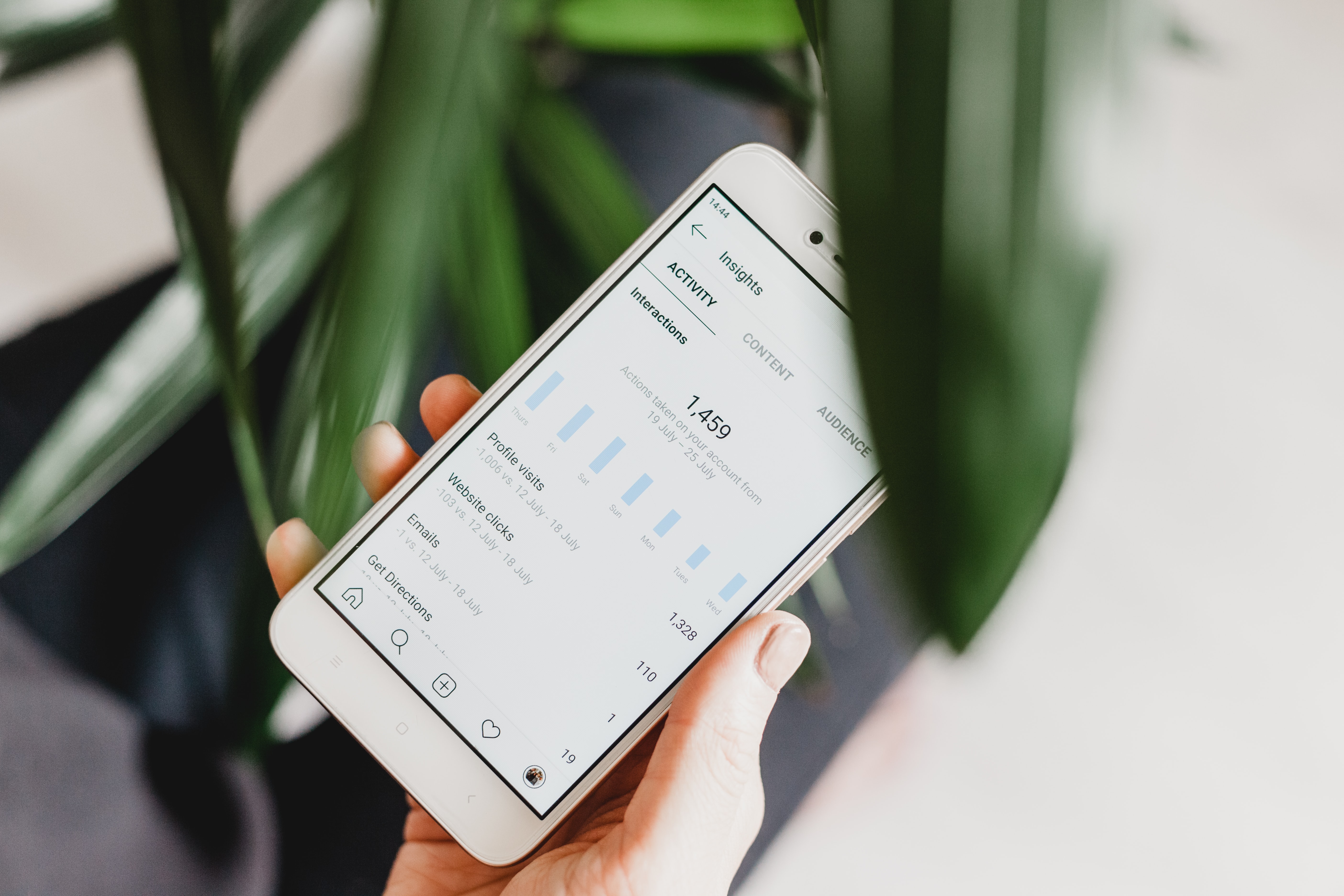
External analytics sit within third-party social media engagement tools like Buffer, Hootsuite, and Sprout Social. They're usually more detailed than internal analytics and allow you to see additional information about how your posts perform over time.
2. Define Your Goals
Once you've established your baseline, it's time to think about what you want to achieve with your social media channels.
Ask yourself some of the following questions:
- Do you want to drive traffic to your website?
- Do you want to increase your follower count?
- Do you want to provide better customer service?
- Do you want to build brand awareness?
You should have at least one goal in mind before you start with any new social media strategy. Next, make sure that these goals are clear and measurable so that everyone on your team understands how to track performance.
If your goal is to add 5,000 followers to our Instagram account by the end of the month, organize your team around this goal and outline the necessary steps to achieve it. For instance, start by having your design team add an Instagram logo vector to your website's homepage so you can turn organic traffic into loyal followers.
For the best results, choose social media channels that both align with your goals and resonate with your target audience. Gen Z is active on Instagram and TikTok, while B2B businesses hang out on LinkedIn and Twitter.

The type of content you post will also play a role in achieving your goals, but more on that later.
Lastly, focus on building your brand voice by finding the tone and language you want to use when communicating with your customers. Rewording tools can be a great way to nail down the tone of your message and find the best to relate to your audience.
Your brand voice is all about making a connection with your audience. You want to connect with people on an emotional level and be relatable — not just by sounding like them and understanding their issues, but also by sharing a little bit of yourself with them.
For example, if you sell kids' toys, you can stick to a friendlier tone.
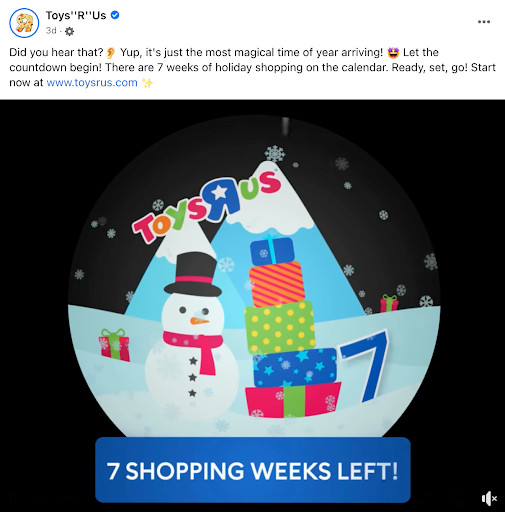
If you are still struggling to find your brand voice, make sure to keep these things in mind:
- Consistency across platforms
- Stay true to your brand values
- Be authentic
3. Create Content
And finally, what've you all been waiting for — it's time to get your creative juices flowing. Let's take a closer look at some of the most popular forms of social media content to grab your audience's attention and encourage them to engage with your brand.
User-generated content
User-generated content (UGC) is one of the most effective forms to boost social media engagement. Brands use customer-created photos and videos to add a personal touch to their Instagram feeds and meet publishing demands.
According to a recent study by Salesforce, UGC can boost engagement rates by 50%. And the reason for this is simple: people identify with user-generated content more than with ads and branded posts. They see themselves in the images, not just some company's product or service.
Take this fall-themed post from Starbucks, for example. It's much more personal than a professional product photo, and they even credit the original user.

Creating a space for your audience to share their own stories and experiences will help you build relationships with them — and ultimately make them feel like they're part of something more. This will be beneficial for word-of-mouth marketing because if customers feel valued, they will recommend your brand to their friends and family members.
Q&A Sessions
A Q&A session is a great way to interact with your audience. Try hosting a live video or posting an Instagram story. Make sure you ask relevant and interesting questions for your audience, but also ensure that you're answering questions from them.
Use Instagram stories to explain your product or service and build trust with your audience — like how this candle company uses Instagram stories to answer questions about holiday coupons and discounts.
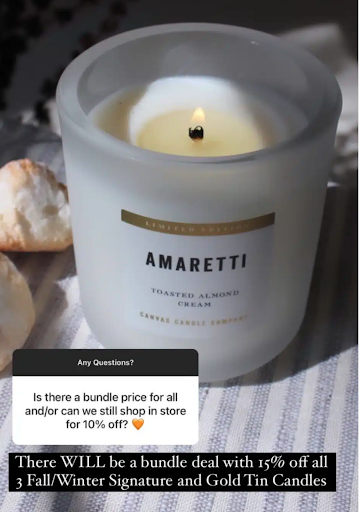
This strategy allows them to interact with prospects, share information about their services, and build brand authority in their niche. And cleverly, they use an Instagram carousel post to increase engagement with the post.
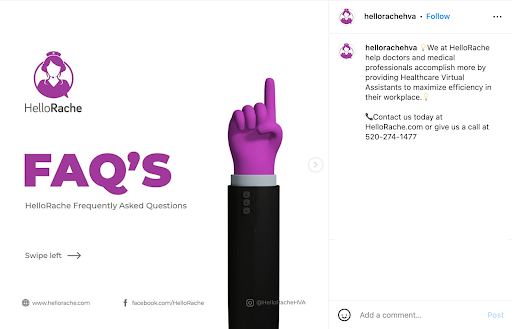
An Instagram carousel post includes multiple pictures, so users must click through all the images to learn more information. Users are more inclined to stop and engage with this post than a standard one with no interaction features (where they read it and keep scrolling).
Polls
Polls are a great way to get people involved in conversations and for brands to learn different opinions on topics. They can also help you get more followers, boost engagement rates, and encourage shares.
Denny's recently ran a Twitter poll about the best way to order your eggs. Did the results surprise you?
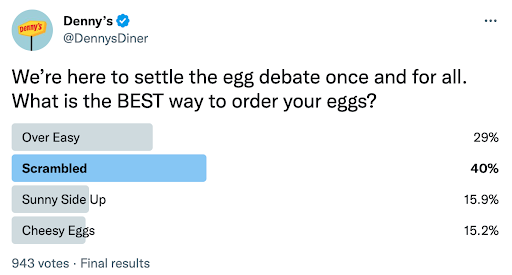
Contests And Giveaways
Who doesn't love the chance to win free prizes? Contests and giveaways are a surefire way to engage customers, encourage them to share your content, and build loyalty in the community you've built around your brand.
Contests encourage customer engagement because they usually require action from participants. For example, the #MyMintMobile Instagram contest required users to comment about a time when their finances and dreams came to life for a chance to win $1,000.
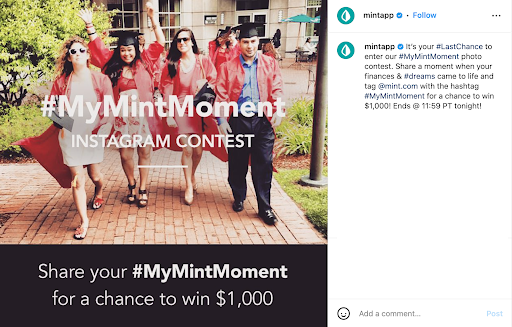
As you can imagine, this Instagram post racked up far more comments, shares, and likes than one of their standard posts.
When customers participate in a contest, they're more likely to feel personally invested in your brand and tell others about it — which can help build brand awareness and convert more leads into sales.
Giveaways allow participants to win something valuable (like free products or gift cards), making them feel like they've won something special without much effort on their part.

If they feel like they've accomplished something, they're more likely to return for more chances to win. This is especially true if the brand offers frequent giveaways, like Jeremy Moser does on Twitter.
So how do you go about publishing all of this newly created content on social media?
Boost Engagement in Your Social Media Channels
Use social media to create valuable content for your target audience and encourage them to interact with your brand. Whether these are TikTok stories, Facebook posts, or Instagram Reels, make sure they give some value to your audience.
But don't worry about making every post perfect or thinking that you have to get everything right from the start. The key is to keep at it and ensure that you're constantly improving without letting your other marketing initiatives fall to the wayside.
Hootsuite analyzed 30,000 social media posts and found the best time (and days) to post on social media. Here are the results:
- Best overall: Tuesdays, Wednesdays, and Thursdays at 10am
- Facebook: Tuesdays and Thursdays from 8am to 12pm
- Instagram: Wednesdays at 11am
- Twitter: Mondays and Thursdays at 8am
- LinkedIn: Tuesdays and Wednesdays at 9am
- TikTok: Thursdays at 7pm
And there are a variety of tools to help you keep up with a posting schedule, so consider adding these tools to your tech stack:
- Make high-quality visual content with a photo editor, use free stock photos, or explore the possibilities of image generation from text to draw attention to your channels.
- Schedule and publish content at optimal times with a social media publishing tool that allows you to schedule Facebook group posts, Instagram posts, tweets, LinkedIn posts, and more from a unified dashboard.
- Keep track of how long it takes to complete tasks with a time-tracking app.
Conclusion
Over time, as your engagement increases, so will your audience size. And remember, these tips can apply to any social media platform (or a combination thereof), so make sure to choose the platform that best suits your business needs.
Social media is about consistency, being open-minded and flexible while respecting users' preferences, and providing value through content curation.
About the author:
Guillaume is a digital marketer focused on handling content management at Wordable. Outside of work, he enjoys his expat life in sunny Mexico, reading books, wandering around and catching the latest shows on TV.
What would you like to know and what would be the best way to share this information with you? What are the best tips & tricks, what workaround do you use? We'd really appreciate your insight on these ones to make our integrations better, more productive, and much more efficient. Comments, tweets are always welcome.